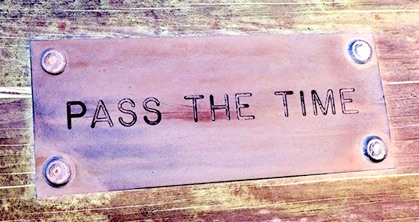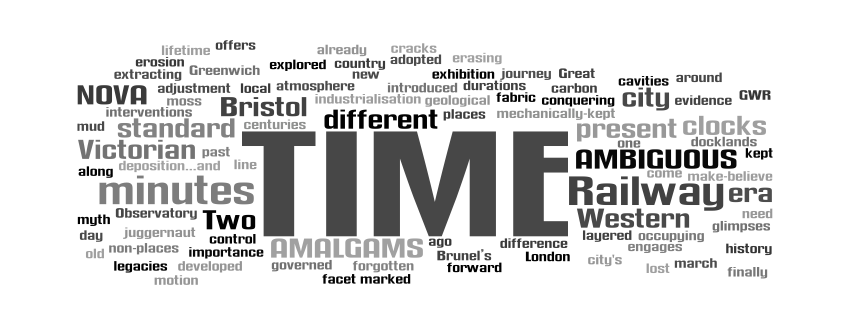

eleven minutes
time and tide
...and the myth of progress
A NOVA Creative Lab project
Western Floating Harbour, Bristol
2006-7

NOVA Creative Lab was established in Bristol in 2005. It is an ever-morphing creative ensemble.
The 'Eleven Minutes' urban trail project was commissioned by Brunel 200. NOVA received technical and funding support from Bristol Harbour Authority, University of the West of England, Aardman Animations and others.
The location of the sculpture trail was the western zone of Bristol. Floating Harbour, including The Underfall Yard, Entrance Lock and other sites dotted around this intriguing urban landscape - a mix that includes working-spaces, road infrastructure, remnant post-industrial sites and ruderal vegetation. The trail's function was not to alter the place, but to alter perceptions, and be a prompt to more intimate exploratory experience of a largely forgotten area of the city - one which is slowly developing a para-wild character, and whose palimpsests hold many richly provocative and poetic connections.
For elements of the 'Eleven Minutes' trail, eco-artist Antony Lyons was joined by two other creative practitioners - Val Steel and Pandora Vaughan.
NOVA Creative Lab also curated and co-produced a connected exhibition at the nearby CREATE Centre gallery space.
We wish to thank all the many people involved, especially the enthusiastic support of the two Lock Masters, Harbour Master, and especially John and his 'under-bridge' team of unsung tidal heroes - Bristol's last surviving working community whose lives operate according to the rhythm of the tidal clock.
Brunel was involved with the docks for 15 years. His contributions included a dredging and sluicing system, an enlarged and improved entrance lock, a tubular wrought iron footbridge and the engine house for the Black Rock water pumping station. It’s great that this art project brings attention to these lesser-known locations.
Andrew Kelly, director of Brunel 200
ELEVEN MINUTES: TALES OF LOST TIME + LOST TIDES - A JOURNEY AMONGST AMBIGUOUS AMALGAMS
During I. K. Brunel’s lifetime, mechanically-kept time developed into something of prime importance. The Victorian railways introduced standard ‘Railway Time’ or 'London Time' throughout the country. The GWR (Great Western Railway) timetables had a different adjustment for each station along the line. For Bristol's new railway station, this adjustment was rounded-up to 11 minutes in the GWR timetables (the true difference, by the sun, being ten and an half minutes). Two clocks were kept at each of the stations - one showing 'true' local time, the other 'railway time'.
On 14 September 1852, the city of Bristol finally adopted standard time; all the public clocks went forward, erasing the time difference, extracting these minutes. From then on, the city's and citizens' timepieces were governed, not by the sun, but by the decree of Greenwich Royal Observatory - an example of the growing centralised 'machine' control that was a facet of the Victorian era. Exactly a century earlier, another time-related adaptation had been foisted on the whole populace of the country, when, in 1752, Britain joined continental Europe in adopting the Gregorian calendar - dropping eleven days between September 2 and 14 of that year. Overall, in the course of the eighteenth century, standard measures of time derived from mechanical clocks gradually displaced the less strict and exact modes of measurement that had previously governed human activity. The standard civic calendar was imposed over the traditional structure of religious feasts and rural festivals.
"For the urban middle-classes, at least, work and social activity were increasingly regulated by clock-time and the calendar rather than by the rhythms of agricultural life. The authority of a single civic calendar was asserted against surviving rural and local practices. Elite agitation for calendar reform culminated in the official adoption of the Gregorian system in 1752, following a legal statute that was justified by reference to enlightened ideals of science and social progress. There was a significant degree of reluctance in some quarters to abandon the traditional Julian calendar, which had tied such customary events as rural festivals and fairs to the cycle of the seasons and the harvesting of crops. In many rural locations, the ‘old style’ dates continued to be used, or the dates of festivals were shifted back in the calendar so they would continue to occur at the same season. Although it seems that stories of widespread riots – with protesters complaining they had been deprived of eleven days of their lives – were mythical, there is no doubt that the calendar reform was at least tacitly resisted."
Jan Golinski, 2003

Walking through this space, this time...
We present a journey - on foot - through these lost minutes of 1852. Into this suspended time arrive strange, ambiguous and tantalising amalgams - scattered remnants from the void, occupying forgotten spaces within the city and the dockland fabric. The route around the Western Docks offers some glimpses through some strata of history, myth, industry and invention. What is revealed is a form of puzzle-in-the-landscape, rewarding those who make the effort to decipher. The act of walking is important here too - in a place that is now heavily dominated by the infrastructure of the motor vehicle. By accessing these spaces on foot, the participants contribute to creating a different ambience, and perhaps help set in motion new imaginative and creative resonances.
These are sculptural interventions in a setting already rich with an atmosphere of tension between old and new, past and present. Different durations and timescales are explored - solar, lunar (tidal), geological, radioactive, carbon - as are some present day legacies of the juggernaut of industrialisation, set in motion two centuries ago. In an era of non-places, NOVA engages with real tactile places, marked and layered with the evidence of time - scratches, cracks, cavities, rust, erosion, deposition...and the slow, conquering march of vegetation, moss and river mud.
The tidal dynamic is a pervasive theme in all the pieces - not only in its marking of (non-mechanistic) time, but also in the growing awareness of how the city has contrived to banish the tide from its daily life. This process went hand-in-hand with the march of industrialisation, as exemplified by IK Brunel. 'Eleven Minutes' seeks to restore some balance by bringing attention to particular places and spaces.
NOTE: The time difference between Greenwich and Bristol is 10 min, 25 sec. Brunel’s GWR railway rounded this up to eleven minutes in their time-tables.
More information is hosted on the Brunel 200 legacy site.
"One could argue that time changed once and for all when the universal regime of Greenwich Mean Time imposed a sense of an arbitrarily encoded universal time for the first time in human history, enabling everyone to calculate for themselves “when,” as in how many hours ahead or behind they were in relation to everyone at every other longitude. This birthed a new time, a new sense of being together in one accounting of time. One could also argue that, after Hiroshima made it possible to imagine that humanity as we know it could auto-destruct, every successive year began to feel as long as a hundred years, or as an epoch, since it could perhaps be our last. This means that, contrary to our commonplace understanding of our “time” as being “sped up,” we could actually think of our time as being caught in the long “winding down,” the “long decline.” It all depends, really, on what question we are asking."
MORE LINKS:








UPDATE JANUARY 2007: FINAL BRUNEL 200 INSTALLATION BY NOVA CREATIVE LAB. THIS IS A LARGE TILED VITREOUS ENAMEL MURAL VERSION OF AN EARLIER TEMPORARY WORK NEAR CUMBERLAND BASIN.
PHOTOS HERE.
NOVA WAS ASSISTED BY THE ENAMEL RESEARCH CENTRE AT THE UNIVERSITY OF THE WEST OF ENGLAND








